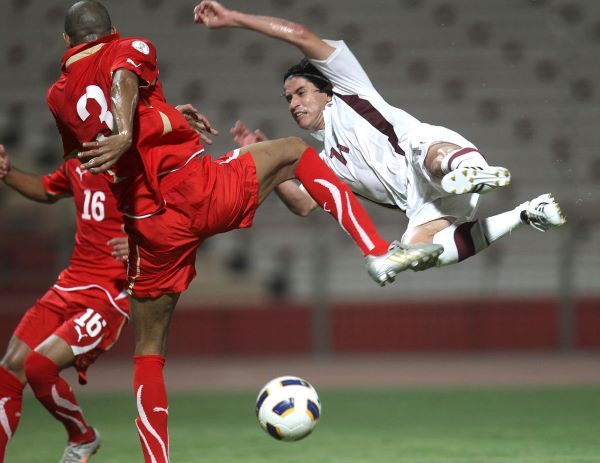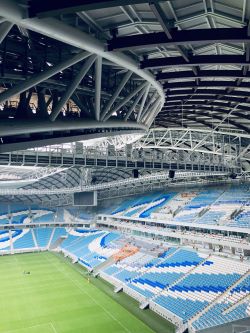SEJournal Online is the digital news magazine of the Society of Environmental Journalists. Learn more about SEJournal Online, including submission, subscription and advertising information.
 |
| A Qatar national team player gets airborne during the 2014 FIFA World Cup qualification match against Bahrain. Later this year, Qatar will host the 2022 tournament. Photo: Faadi Al Assaad, Doha Stadium Plus Qatar, Flickr Creative Commons (CC BY 2.0). |
Feature: Can Qatar’s World Cup Really Be Carbon Neutral?
By Craig L. LaMay
When FIFA, the international soccer governing body, chose Qatar to host the 2022 World Cup, to be held Nov. 21 to Dec. 18, it was on the country’s promise that it would deliver the first carbon-neutral tournament. That vow seems unlikely to be fulfilled, given Qatar’s harsh climate, and raises questions about who will measure the country’s success and how.
To be fair, those questions attend all sports megaevents, wherever they are held, but they become more problematic when these competitions are held in countries without journalists and news organizations free to investigate them.
Concerns about the environmental impact of major sporting events have been around since at least 1924, when the citizens of Chamonix, France, complained to Olympic organizers about the effects of infrastructure construction for the first Winter Games.
It would be another half century before another venue, Sapporo, Japan, would make environmental considerations an explicit part of its Olympic bid, again in response to local opposition.
Only in 1991 did the International Olympic Committee amend its charter to require host cities to hold the Games under “conditions which demonstrate a responsible concern for environmental issues.” Three years later the IOC made “environment” the third pillar of Olympism, and in 1996 the IOC amended the charter again with a commitment to “sustainable development.”
Ambitious promises raise big questions
The other giant in the world of sport megaevents, FIFA, first announced “green goal” initiatives for its 2006 and 2010 World Cups in Germany and South Africa, respectively. In 2009, FIFA established a requirement that any bidding country include in its bid an environmental impact discussion, and in 2016 it joined the UN Sports for Climate Action Framework. Today, FIFA’s environmental program emphasizes waste, water, energy, transportation, procurement and climate change.
It was a surprise to everyone when,
in 2010, FIFA awarded the 2022 World Cup
to Qatar, one of the world’s smallest countries
and its largest producer of natural gas.
For these reasons (among others related to corruption and human rights) it was a surprise to everyone when, in 2010, FIFA awarded the 2022 World Cup to Qatar, one of the world’s smallest countries, with a population of about 3 million, and its largest producer of natural gas.
The country’s hot climate and desert landscape present obvious environmental challenges, and the tournament had to be moved from summer to late fall because Doha’s summer temperatures are consistently 95°F (35°C) or higher, with high humidity as well.
But, unlike the other bidders, Qatar’s bid book committed to “zero carbon emissions through strategies such as the adoption of sophisticated air-conditioning technologies.”
Against that promise are some tough facts. Qatar is the world’s highest carbon emitter on a per capita basis. It also ranks near the top on water consumption and waste generation per capita. The country is entirely desert and has almost no fresh water resources.
Critics have consistently charged that Qatar’s World Cup bid pledge was public relations. To be credible — and to deliver the promised national legacy for the tournament — carbon neutrality means actually reducing and eliminating emissions and not just buying carbon credits.
Carbon emissions, water are key challenges
So how is Qatar going to meet its zero carbon emissions commitment?
Qatar is using the Global Sustainability Assessment System, developed by its own Gulf Organisation for Research and Development, to certify buildings and stadiums. In practice that certification means that all unavoidable carbon emissions, most obviously from construction and from travel, must be offset by other natural capital projects (or by carbon credits) if the tournament is going to achieve carbon-neutral status.
So far, Qatar’s most obvious achievement is that it has built eight stadiums (instead of the originally planned 12), all of them within a 60-mile radius, greatly reducing the cost of traveling to games. All eight have onsite solar power, all have outdoor air-conditioning systems and all but one is connected by a new metro rail system. Every stadium but one has also been built in a modular fashion such that it can be partially disassembled, then shipped to developing countries and reassembled.
 |
| Qatar’s Al Janoub Stadium is one of seven stadiums built in a modular fashion for the 2022 World Cup. Photo: Gazanfarulla Khan, Flickr Creative Commons (CC BY-NC-ND 2.0). |
The biggest outstanding challenge is the country’s lack of fresh water. Qatar averages 3.1 inches (80 millimeters) of rain per year. As that’s not enough to supply drinking water or fill aquifers, all the country’s potable water comes from desalination, a process that requires burning fossil fuels.
Despite this, Qatar has chosen to use natural grass in all eight stadiums — grass that requires a lot of water. While Qatar plans to recycle and reuse water, including wastewater, in the stadiums, the country might have used its 12-year lead time on the tournament and invested its plentiful resources in developing better artificial turf, which would have both saved money and, perhaps, bought Qatar some reputational reward.
Existing artificial turf technologies have their own environmental problems, but there is also an equity issue here. The 2015 Women’s World Cup in Canada was played on artificial turf, with the defense from FIFA that the “extreme climate” there did not support natural turf. Somehow this argument doesn’t apply to Qatar.
A World Cup played on new and advanced artificial turf would be standard-setting for all sports, but in the snobby world of football politics it would also be risky. It is likely that introducing any kind of artificial turf to such a high-profile event would simply feed critics’ claims that Qatar is not a real football country.
Accusations of ‘sportwashing,’ greenwashing
Finally, both the politics of international sports and domestic politics are inseparable from any consideration of Qatar’s carbon-neutral claims.
Both FIFA and the IOC are regularly accused of allowing the hosts of their competitions to use them for “sportwashing” their political reputations, but also for greenwashing the competitions themselves.
Almost always these events are promoted to advance the contradictory goals of promoting brands, markets and locations that lack the infrastructure to host them, while also claiming to promote an environmentally friendly agenda.
While both organizations require bidders to
include an environmental program in their bids,
there is no way to ensure hosts keep their promises.
And while both organizations require bidders to include an environmental program in their bids, there is no way to ensure hosts keep their promises or, in most cases, to measure them.
Further, the record of corruption in international sports bodies, particularly FIFA, does not inspire confidence in its environmental commitment.
Within Qatar — a country with no free press and no public right to government information — researchers and reporters have to rely on whatever data the government is willing to share, if any.
Local news organizations, including Al Jazeera, will not risk any in-depth reporting beyond the government’s official claims about the tournament’s legacy, whether related to the environment, labor or anything else. Al Jazeera covers the Arab world and the Global South admirably, but like other Qatari news organizations does virtually no critical domestic news coverage — Qatar’s antiquated 1979 media law and its penal code all but prohibit it.
Putting megaevent environmental claims to the test
This won’t be Qatar’s last time on the world sporting stage either. Like its Arab Gulf neighbors, the United Arab Emirates and Saudi Arabia, Qatar has chosen to invest heavily in international sports competitions (and in Qatar’s case, sports media, through its international broadcaster beIN Sports).
But Qatar has also committed to hosting premier global events, not just regional ones. Having failed twice to get the Summer Olympics, it is determined to host the 2036 Games. If it succeeds in its ambitions, those games will probably, like the World Cup, need to be moved to late fall or winter. In September 2019, Doha hosted the World Athletics Championships, but not without some events being compromised by the extreme heat.
It took decades for international sports organizations to recognize the environmental consequences of their competitions. Now it is time for journalists to cover critically their public commitments, especially as they comport with their moral claims about the value of sport. The Winter Olympics, for example, not only happen mostly outdoors in spectacular natural locations but are becoming increasingly unsustainable because of global warming.
But all sports megaevents have enormous human and environmental costs. Organizers, hosts, corporate sponsors, media rights holders and even sports reporters will all make great claims for them. Environmental reporters can do a lot to put those claims to the test.
Craig LaMay is a professor and former dean at Northwestern University in Qatar, where he directs the journalism program. He teaches media law, currently writes on sport broadcasting and piracy in the Middle East North Africa region, and is the former Middle East editor of the International Journal of the History of Sport. Way back in the day, he was the first opinion editor for the SEJournal.
* From the weekly news magazine SEJournal Online, Vol. 7, No. 29. Content from each new issue of SEJournal Online is available to the public via the SEJournal Online main page. Subscribe to the e-newsletter here. And see past issues of the SEJournal archived here.













 Advertisement
Advertisement 



